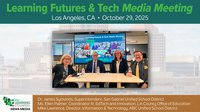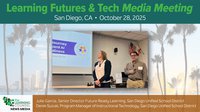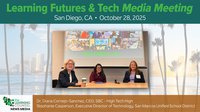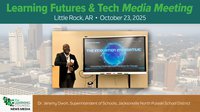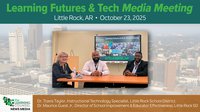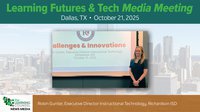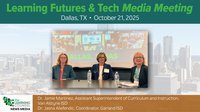Is it time for educators to rethink curriculum development? Are students ready to take the first steps? Is technology the way forward? The Barnes and Noble report “Emerging from the pandemic, reimagining higher education” reveals that almost half (49%) of surveyed students prefer a hybrid class format. But faculty members seem out of touch with the new generations—just 35% of educators say they favor a hybrid environment.
Will the metaverse enable more educators to easily set up hybrid environments, and therefore be more in touch with the next generation?
If the term metaverse describes a virtual world where people can interact with each other and digital content in immersive and realistic ways, any hybrid education experiences is part of the metaverse. But what exactly can the metaverse do for education? Let's explore the challenges and opportunities, look into leading education projects, and understand why its role is essential not just for students but economies around the world.
Going Beyond the Challenges of Digital Learning
According to a survey by BestColleges, 75% of online students reported feeling isolated or disconnected from their peers and instructors during their studies. Moreover, 62% of online students said they missed having access to campus resources and facilities.
The biggest challenges of the metaverse for education projects are the gaps that technology presents. These digital tools are agile, instant, inclusive, customizable, and help students engage with education content on another level. But the lack of social components has often challenged modern tools.
These findings suggest that distance education needs to address not only the cognitive but also the affective and behavioral aspects of learning. Students need more than just information; they need motivation, engagement, collaboration, feedback, support, and community. And this is where the metaverse comes in.
The metaverse can offer some unique advantages over traditional online platforms. With or without the need for augmented reality and virtual reality (VR) headsets, education developers can use mobile, web, or intelligent digital displays to create immersive learning environments that simulate real-world scenarios and contexts. Entire classrooms can be replicated in virtual environments, otherwise known as digital twins. Or mixed reality systems can blend physical classrooms with virtual ones. These experiences can foster social presence, inclusiveness, and interaction among learners and educators across time zones and geographies.
Furthermore, the metaverse can also enable new forms of pedagogy that leverage gamification, personalization, creativity, exploration, experimentation, and discovery. These elements can increase student motivation, engagement, and retention, as well as develop critical thinking, problem-solving, communication, and collaboration skills.
Metaverse Experiences of Leading Education Institutions
Some of the most respected educational institutions are already exploring the possibilities of distance education in the metaverse. Stanford University has created Stanford VR, and it was one of the first institutions to offer virtual courses—starting in 2021.
Metaverse education content can allow students to dive deep into distant environments, almost always inaccessible. These immersive virtual experiences can be used to teach maths, science, geography, industrial engineering, energy, oceanography, or space studies. For example, students can learn about human anatomy by exploring virtual bodies, discover environmental science by visiting different ecosystems around the world, and even explore distant celestial objects millions of light years away. The possibilities are endless.
One of the universities which quickly realized this potential was Arizona State University. They partnered with Dreamscape Immersive to create Dreamscape Learn—VR courses on oceanography, astronomy, and biology. Students can access these courses through VR headsets at select locations across the U.S. or through their own devices at home.
The University of Oxford also joined in and launched Oxford VR. This spin-off company uses VR technology to deliver evidence-based psychological therapies for mental health conditions like anxiety, depression, and phobias. Students can access these therapies through VR headsets at clinics or home. In similar ways, almost every leading educational institution in the world has been experimenting with VR, paving the way forward to better prepare students for their future.
Why Students Need to Master Metaverse Technology
Modernizing education to adapt to the skill sets that future generations will need is essential. A recent Dell study found that almost half (44%) of surveyed Gen Z adults aged 18 to 26 say their education provided very basic computing skills. One in ten (12%) revealed they had received no education in technology or digital skills at all.
The Dell study titled “Elevating the voice of Gen Z to shape the economies of tomorrow” also revealed that Gen Z adults view investments in technology as critical to securing universal connectivity, narrowing the digital divide, and enhancing healthcare, governments, and education. 64% believe technology will play an essential role in the fight against climate change.
The education gap is already causing severe problems in the job market as companies digitally transform and adopt new technologies. The 2023 Hays U.K. report found that 94% of companies faced a lack of skilled workers last year, up from 89% the year before. Tech skills gaps are intensifying, and fewer young people are engaging in tech careers.
Additionally, metaverse technology is already being used by almost every industry. The fourth industrial revolution is already in full swing, transforming education, agriculture and livestock, manufacturing, energy, healthcare, and every other major sector.
This fourth industrial revolution is driven by artificial intelligence (AI), automation, data analytics, robotics, Industrial Internet of Things (IIoT) devices, satellite technology, Web3, blockchain digital twins, 3D printing, and more. These innovations are interoperable with the metaverse and are essential foundational blocks for growth.
Building Foundations Today for Future Generations
The students of today have to master metaverse technology as it will be part of their daily lives at school, colleges, and universities. Metaverse hybrid learning experiences can provide the best of both worlds for students by fusing in-person worlds with virtual ones. They can inspire, educate, and impress values and missions while incentivizing creativity and original thought.
It is the responsibility of educators worldwide to impart the proper knowledge and give new generations all the tools and resources to help them fully reach their maximum potential.
About the author
Austin Yavorsky is the CEO and Co-Founder of Landian, a metaverse company, with almost 30 years of experience as a serial entrepreneur. He specializes in integrating technology to develop real-world solutions and is an active investor and advisor. Austin is also a Diplomatic Peace Mediator and Mediator Judge of Peace for the United Nations, having worked with governments, the Vatican, and Fortune 500 companies on future technologies, sustainable energy, and agriculture.




